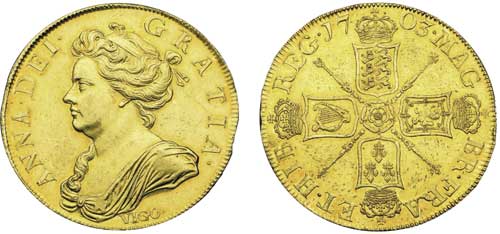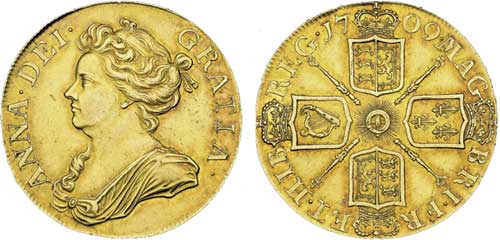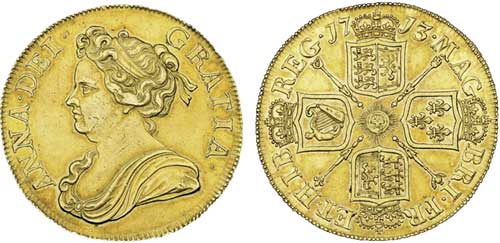
1703 VIGO five guineas
One of the most valuable of British coins.
S.3561
Courtesy of Spink
William III <-- : : --> George I

1703 VIGO five guineas |
The following is extracted from the Spink Auction Catalogue for the Samuel King Collection, 2005.
On the October 12th 1702 a powerful Anglo-Dutch fleet, under the command of Admiral Sir George Rooke, engaged and destroyed a Franco-Spanish bullion fleet sheltering in Vigo bay on the north-eastern coast of Spain.
Rooke's fleet was returning to England after a failed attempt to take the port of Cadiz following the outbreak of hostilities in what was to become the War of Spanish Succession.
Despite achieving near total victory the English and their allies, as a result of Spanish foresight, only recovered a modest quantity of precious metals of which less than 4,500 lb of silver and the paltry sum of 7lb and 8oz of gold made it to the Mint. The destruction of the enemy fleet inflicted a serious blow to the reach of French naval power and the significance of the action was clearly perceived at the time.
The bullion was transported to the Tower with considerable pageantry and the then Master of the Mint, Sir Isaac Newton, noted for his frequent absences, personally oversaw the delivery. A royal warrant was subsequently issued causing the bullion to be coined and the word 'VIGO' to be inserted under Queen Anne's bust in order to 'Continue to Prosterity the Remembrance of that Glorious Action.'
The VIGO gold issue of 1703 was intended for circulation and comprised Half Guinea, Guinea and Five Guinea pieces. The dies were the work of the Mint's Chief Engraver, Henry Harris and his assistant John Croker. Each denomination is excessively rare and while exact numbers struck are unknown it is believed that fewer than 15 Five-Guinea pieces are in private collections.
According to Spink's records only four other examples have been offered at auction in Britain in the past 45 years. The VIGO Five Guinea piece is one of the most desirable coins in the entire English milled gold series.
For a detailed account of the battle and its consequences see H. Kamen, 'The Destruction of the Spanish Silver Fleet at Vigo in 1702', Numismatic Circular, June 1966 and C. Challis (ed.), A New History of the Royal Mint, Cambridge, 1992, p.433
This particular coin sold for a hammer price of 130,000 GBP, a record for a five guinea piece.

1706 five guineas, first bust and wide shields reverse
|

1709 five guineas, first bust and narrow shields reverse
|

1713 five guineas, second bust
|
Five Guineas of William III <-- :
: --> Five Guineas of George I
Main Site Index
Main Pictures Index
Index for Coins of Queen Anne
Pictures of Coins of the UK - Queen Anne (5g)
Copyright reserved by the author, Tony Clayton
v6 2nd January 2016
![]()